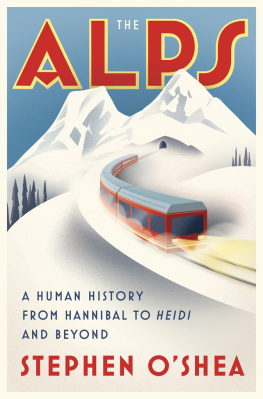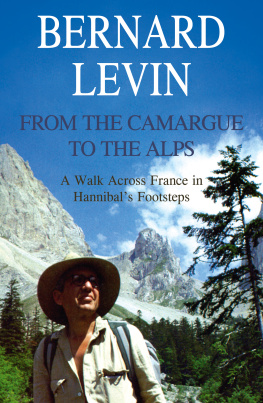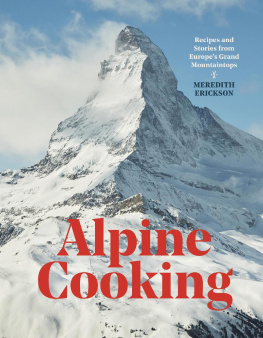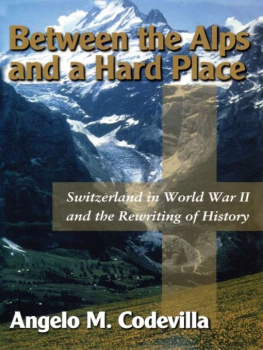
ALSO BY
S TEPHEN OS HEA

Back to the Front: An Accidental Historian Walks the Trenches of World War One
The Perfect Heresy: The Revolutionary Life and Death of the Medieval Cathars
Sea of Faith: Islam and Christianity in the Medieval Mediterranean World
The Friar of Carcassonne: Revolt Against the Inquisition in the Last Days of the Cathars
THE
ALPS

A Human History from
Hannibal to Heidi and Beyond

S TEPHEN OS HEA

Copyright 2017 by Stephen OShea
All rights reserved
First Edition
For information about permission to reproduce selections from this book,
write to Permissions, W. W. Norton & Company, Inc.,
500 Fifth Avenue, New York, NY 10110
For information about special discounts for bulk purchases, please contact
W. W. Norton Special Sales at or 800-233-4830
Book design by Marysarah Quinn
Production manager: Anna Oler
Jacket Design and Illustration by Nicholas Misani
ISBN: 978-0-393-24685-8
ISBN: 978-0-393-63419-8 (e-book)
W. W. Norton & Company, Inc.
500 Fifth Avenue, New York, N.Y. 10110
www.wwnorton.com
W. W. Norton & Company Ltd.
15 Carlisle Street, London W1D 3BS
T O MY H ELPERS ,
H. Ellison, Dana H., Edward H., Ernst H.
C ONTENTS
T HE BEST DESCRIPTION OF THE ALPS Ive seen comes from a geologist, Richard Fortey, in Earth: An Intimate History . Writing of the violent collision of European and African tectonic plates over millennia, he says, Alpine mountains might be seen as badly made lasagne, crudely layered and buckled in the cooking. The result of a mountain-building process that began about sixty-five million years ago, the Alps form a fearsome, gargantuan intrusion of stone inconveniently located not at the edge but square in the middle of Europe.
I lived almost two decades in Paris, then another few years near Perpignan, in the shadow of the Pyrenees. All the while, I was drawn to Europes most evocative mountain range, the Alps, again and again. I have overflown them, taken trains through their tunnels, driven over their heart-stopping passes, and skied down their slopes.
There is a temptation to dismiss the Alps as simply a winter wonderland, a backdrop for skiers taking pictures of themselves with stuffed marmots. They are much more than that, and always have been. The Alps impede the passage between northern and southern Europe. Their size and inaccessibility have made them the source of divisionsin language, cuisine, culture, religion, history, and much more. It is this human geography that interests me most. Their hidden valleys have seen the march of armies since Antiquity, witnessed the clanking of Crusaders and the tramp of pilgrims. Tradesmen have struggled over their passes, as have bishops, emperors, noblewomen, and thieves. Fourteen million people live in the Alps, and many of them cannot talk to one another, so great are the language barriers created by the mountains. Disruption , to use a term now in vogue, has been their role in a colorful history.
Before satisfying my curiosity by journeying in their midst, I was unaware that these mountains were the midwife of the Romantic Revolution, that they changed the very way we look at nature, that what was once considered forbidding ineluctably became erotic. The Alps more or less invented tourism, and they ushered in the mania for winter sports. They have inspired artists and criminals. They have also stood as a challenge for people of great courage and intellect. Mountaineering came of age in the Alps, as did the science of geology. They have been the stage for marvelous engineering achievement and the setting for horrible disaster.
Taken together, the various Alpine ranges cover a Kansas-sized 210,000 square kilometers and stretch from France to Slovenia in a 1,200-kilometer arc that is 200 kilometers at its widest. That makes for thousands of peaksmonstrous, medium, and modestas one proceeds from west to east. There are 1,599 Alpine peaks with an altitude exceeding 2,000 meters. After much head-scratching, I opted to take a route from west to east, from Lake Geneva in Switzerland to Trieste in Italy. This meant that I could engage with the mammoth heights first, while I was still fresh. More important, I decided to concentrate on the high passes of the Alps rather than their high peaks. It is by cresting a pass that one sees the diversity in human geography, learns the different stories told on either side of the height, finds out that what is goofy on one side may be grand on the other. With a high pass, you go through the trees, then they fade away, until you are at a tundra height overlain with snow. Downward you go, around dozens of hairpin turns, and usually you end up in someplace entirely different. You may have passed a national boundary, a lard line (pork fat vs. olive oil), a linguistic cleavage (from the Germanic to the Latin or the Slavic), a shift in architecture, or a sudden change in human behavior and custom. To someone who has always been interested in boundaries and differences, the Alpine passes proved irresistible. I am hardly alone in this feeling. Writing in 1904, British mountaineer William Conway observed,
To climb a peak is to make an expedition, but to cross a pass is to travel. In the one case you normally return to the spot whence you set out; in the other you go from the known to the unknown, from the visible to what is beyond. The peak, which is before you when you set out to climb it, is only explained, not revealed, as you ascend; but every pass is a revelation: it takes you over into another region. You leave one area behind and you enter another; you come down amongst new people and into fresh surroundings. You shut out all that was familiar yesterday and open up another world.
This journey will necessarily be automotive, a vertical road trip for the stout of heart. The ground to be covered is vastsix Alpine countries, tens of thousands of meters up and down, up and down. I do not intend this to be an exhaustive itinerary covering every passthat is an outright impossibility, given their number. Rather, I will concentrate on those with the most stories to tell. The vistas will be magnificent, scary even, but the insight gained might just be well worth the effort and the fright.
And did I mention that Im afraid of heights?
T HE HIGHEST MOUNTAINS OF THE A LPS are called four-thousandersfor their metric elevation. Road signage everywhere in the mountains shows kilometers. Signs at the mouth of a tunnel inform you of the distance, in meters, you can expect to be driving in darkness. The Alps are incontestably metric mountains.
Accordingly, throughout this book I have used the metric system. A kilometer is 0.6 mile; thus, 100 kilometers equal 60 miles. The meter is 3.28 feet in length. So, if you insist on getting a foot value for the elevations of peaks and passes, use 3.28 as a multiplier, or 3 and then some. Or just think: slightly longer than a yard.
But I will not abandon our irrational system entirely. Snarled traffic will still inch along, a nearby object will still be a few feet away. A six-foot-tall man will remain six feet. Consistency is vastly overrated, so in the particulars of daily life I shall revert to the familiar. In this I take my cue from a former leader of the French Communists who, when called out on an inconsistency, used to say, Such are my contradictions!
Next page













